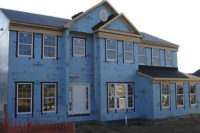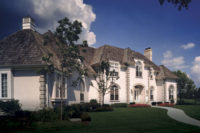As the year end approaches, there continues to be considerable discussions about the changes coming to the building codes and state adoption process. This article will cover some of the challenges traditional three-coat plaster clad wall assemblies face in code compliance and functional installation.
At this point, most states have adopted the latest ASHRAE 90.1 Standards as a guideline for new construction to meet the 2013 Energy Efficiency Standards. The updated codes require new buildings, excluding low rise construction, to increase the insulation value of the structure by 30 percent. New buildings not in plan check by the end of 2013 will not be issued building permits without meeting or exceeding the new energy standards. The new calculations for R- and U-values for wall assemblies are determined by a calculation based on the climate zone where the building is located.
Here is an excerpt from the U.S. Department of Energy’s Web site:
“The U.S. does not have a national energy code or standard, so energy codes are adopted at the state and local levels of government. Through the Building Energy Codes Program, DOE provides technical assistance to state and local governments to help facilitate the adoption process. This support also includes tracking state adoption status, coordinating activities among stakeholders and technical analysis.”
Based on this calculation, in order to comply with the higher energy efficiency requirement, many architects are adding rigid exterior insulation to the wall assembly. Among several challenges of this design, the depth of the insulation from the substrate can vary from 1 to as much as 4 inches. This makes traditional lath attachment challenging due to the fastener length being increased to accommodate the lath being extended away from the framing.
This creates a cantilevered effect on the fastener once the full weight of the plaster is applied to the lath. This weight is anywhere from 10 to 14 pounds per square foot. Laboratory testing has shown that the deflection rate on the fastener can be .10 or more inches in steel framed structures.
This is sufficient enough to cause unacceptable cracking in the plaster. Areas of the country with seismic activity or high speed wind conditions should also have concern with this design due to shear failure potential of the fasteners or fasteners pulling through the lath.
THE DEVIL IS IN THE DETAILS
Another area of concern is termination points. If contractors mount traditional casing beads and weep screeds over the insulation, more long fasteners and custom end cap pieces will be needed to close the wall assembly for waterproofing requirements.
WEATHER RESISTANT BARRIERS
Weather resistant barriers underneath the rigid insulation can be damaged during the installation of the insulation and the lath. Liquid applied weather resistant barriers will have similar issues, although some manufacturers are promoting some self healing properties in their barrier systems.
Self adhered flashings are being used more and more to deal with moisture barrier penetrations. These flashings are not designed to be applied over rigid insulation. Designers, building envelope consultants and contractors will need to carefully detail the layout of these products on the substrate prior to the rigid insulation being installed.
“Z” CHANNELS
“Z” channels are designed to go over vertical framing and can be ordered in different widths to accommodate different rigid insulation dimensions. This design eliminates the deflection problem mentioned earlier; however, the metal behind the plaster can photograph an image into the plaster as the building heats up and cools down. This will develop a “picket fence” look even through painted surfaces. Thermal break tape is recommended on each side of the channel to stop this from occurring. Custom end caps and corner pieces also have to be manufactured to finish these wall design types.
PROPRIETARY LATH SYSTEMS
Several manufacturers are bringing products to the marketplace to provide solutions to the new code that address the short comings of the aforementioned designs. Dow Knight CI System, AMICO and the Diamond-Furr CI System by CEMCO, just to name a few. The Diamond-Furr CI System has been included in the 2013 TSIB’s Energy Code and Plaster Assemblies Handbook although it is not mentioned by name, only as a proprietary design. Diamond-Furr is a complete system for flashing and lath attachment incorporating rigid insulation. The system is designed specifically for three-coat plaster.
ASTM 1063 C requires lath attachment at a maximum of 7 inches on vertical framing. This would mean more than 100 fasteners required to attach the lath in a 10-foot-by-10-foot wall area, with no way to inspect the condition of the barrier under the insulation after the lath has been installed. Cornerbeads also will produce additional penetrations. The Diamond-Furr System addresses these penetrations and reduces them by 55 percent and the remaining barrier penetrations are serviceable prior to the insulation being installed.
THERMAL BRIDGING AND THERMAL IMAGING
The primary directive behind the new energy R- and U-value calculations is the ASHRAE report about the use of typical batt insulation used in between framing members. The term “thermal bridging” means that the framing members allow a pathway through the wall assembly to release heat out or allow heat into the building envelope. This bridging reduces the energy efficiency of the building, especially in steel framed construction. Continuous insulation is used as a way to combat this event.
Thermal imaging is a technique using a special camera to detect heat loss and air permeability in buildings through the use of infrared light. The infrared spectrum visible through the camera shows color changes due to temperature fluctuations thereby identifying the leaks.
There are different descriptions for continuous insulation in ASHRAE 90.1 and the IBC, as well as a continuing debate about different wall assemblies meeting the requirements. The Technical Information Services Bureau of the Western Wall and Ceiling Contractors Association has published a list of assemblies that they believe meet the new Energy Efficiency Standard in regards to plaster clad wall assemblies.
The National Fire Protection Association will also weigh in on the wall design. NFPA 285 is scheduled to be mandatory on all structures 40 feet above grade in 2015, regardless of framing type. Complete wall assemblies will need to be tested in order to comply. More information is available at www.nfpa.org.
WHO MAKES THE FINAL DECISION?
As with any new code change to building design, there will be collaboration between the building owner, designer, general contractor and plaster subcontractor prior to construction. Government building officials, waterproofing consultants and various product manufacturers will also have input in new and retrofit building designs. Cost factors will also be influential on final design choices. But who makes the final decision on how to proceed? It will be important for the plaster industry to promote a sustainable design that will satisfy all of the requirements of the new code and minimize potential defect litigation. With the increased building cost of the new code requirements, three-coat plaster has an opportunity to recover some ground lost to other claddings in the construction industry.









Report Abusive Comment